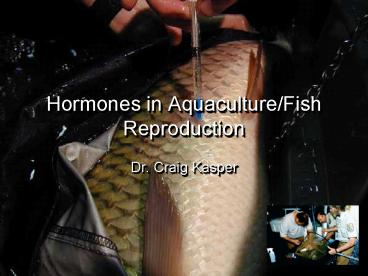Hormones in Aquaculture/Fish Reproduction - PowerPoint PPT Presentation
1 / 23
Title:
Hormones in Aquaculture/Fish Reproduction
Description:
New innovative hatchery techniques have evolved as global demand for fish ... For example, sturgeon and paddlefish have no ovarian sac; the eggs are released ... – PowerPoint PPT presentation
Number of Views:625
Avg rating:3.0/5.0
Title: Hormones in Aquaculture/Fish Reproduction
1
Hormones in Aquaculture/Fish Reproduction
- Dr. Craig Kasper
2
Introduction
- New innovative hatchery techniques have evolved
as global demand for fish increases. - Many fish spawn in environments that are nearly
impossible to simulate in a hatchery. - Hormone-induced spawning is the only reliable
method to induce reproduction in these fishes. - Now fish may be spawned nearly any time of year
providing environmental conditions and cues are
correct for the target species.
3
Hormones/Fish
- Hormone induced spawning of fish is nearly 75
years old! - Surprisingly, many techniques havent changed
much during this period. - Fish such as carp, catfish, seabass, redfish and
snook were used as test fish. - Induced spawning for many other fish became
merely a modification of what was already being
done.
4
Why Induce Fish to Spawn?
- Hybrid production
- Sterile fish (polyploidy)
- Synchronous spawning
- (simplifies production)
- Max. production of fry
- Produce fish outside
- normal season (!!)
5
Fish Handing
- Of course be careful!! REM These are broodfish
and money is at stake! - Fish should be captured, handled and spawned with
the greatest care possible. (Females will
reabsorb eggs if roughed up!) - Optimal environmental conditions are required to
maximize spawning potential.
6
Sexual Maturity Revisited
- Ensuring the sexual maturity of your fish is
important. - Males can be checked or milt easily, but females
are more difficult (may require a microscope)
7
Environmental Conditions
- photoperiod
- water temperature
- water quality (e.g., dissolved oxygen, pH,
hardness, salinity, alkalinity) - flooding and water current
- tides/lunar cycles
- weather cycles (e.g., atmospheric pressure,
rainfall) - spawning substrate (e.g., aquatic plants, sticks,
gravel, mats, caverns) - nutrition
- disease and parasites
- presence of other fish.
8
Egg/Sperm Acquisition
- 1. Tank spawning
- 2. Hand stripping (taking eggs)
- 3. Surgically removing the eggs
9
1. Tank Spawning w/hormones
- Simplest method for obtaining a hatchery spawn.
- Brood fish of both sexes are placed together in
the spawning tank following injection(s). - Brood fish should not be disturbed and subdued
lighting is recommended. (Frank Sinatra doesnt
hurt) - The female ovulates when she is physiologically
ready. - Male will stimulate the female to release eggs.
10
Tank Spawning
- Fertilization improved if males are
preconditioned (injected prior). - Males can be used for several tank spawns.
- Two or three males/female/tank can be used to
ensure fertilization. (unless aggressive) - If tank size permits, then more groups may be
in one tank.
11
(No Transcript)
12
Tank Spawning Advantages
- Skilled workers (predicting the exact time of
ovulation or checking females) - Verifying ovulation is unnecessary
- Rapid deterioration of eggs in the ovary after
ovulation is not a problem. - Unnecessary to check and strip the fish
(ltinjury). - Less labor required!
13
Tank Spawning Disadvantages
- Egg collector or suitable spawning substrate
needed - Dirt/debris with the eggs, or egg clumping
fungus - Some females may not release all their eggs!
- Estimation of fecundity difficult.
- Cant used method for polyploidy
14
Hand Stripping
- Also a common technique.
- Broodfish kept separate.
- Ovulation verified when eggs flow freely from the
vent (most spp.) (or with ultrasound!) - One hour prior to anticipated spawning females
are checked again. - Tropical species every 45 minutes or less, temp.)
15
(No Transcript)
16
Hand stripping
- The fish is turned belly up and gentle finger
- pressure is applied to the abdomen starting
at - the pectoral fins, moving
- slowly toward the vent.
- Do not try to squeeze or force
- the eggs from the fish (injury)!
- If you only get a few eggs,
- then put er back!
- She aint ready!
17
If you make a mistake
Sacrificing your broodfish for poor technique is
never a good feeling.
18
Hand Stripping
- Water cant touch the eggs at this point!!
- Water activates sperm and closes the micropyle
(hole where sperm enter egg.) For many fish,
this closure takes place within only 45 to 60
seconds. - Solution Keep a towel handy!
- Stripping of eggs used the same technique as
checking for ripeness. Firm pressure and
steady flowing motions are better than driving
them out with force.
19
Surgical Removal
- Yes, sometimes it becomes necessary to do this.
- Anatomy of some fish wont allow efficient strip
spawning. - For example, sturgeon and paddlefish have no
ovarian sac the eggs are released into the
abdominal cavity during ovulation.
20
Surgical Removal
21
Fertilization
- Once youve got the eggs, repeat the same
stripping technique with a male fish. - Milt can be added to eggs and them slightly
agitated by swirling, mixing with glass rod, or
turkey feather. - Next add some water. Hardening of the eggs will
occur within several minutes in some spp. - Move eggs to the appropriate McDonald jar, etc.
22
Sticky Eggs?
- In the wild, eggs stick together or adhere to
substrate, but in the hatchery this isnt
desirable. - Silt-clay
- Bentonite
- Fullers Earth
- Diatomaceous Earth is bad (sharp edges of diatoms
damage eggs).
23
Sticky Eggs
- The silt-clay suspension (saturated) is combined
with fertilized eggs at 2 to 4 parts suspension
to 1 part fertilized eggs. (20 minutes) - Other options
- Tannic acid
- Urea and salt
- Sodium sulfite
- (for recipe and mixing instructions see SRAC
handout 426)































